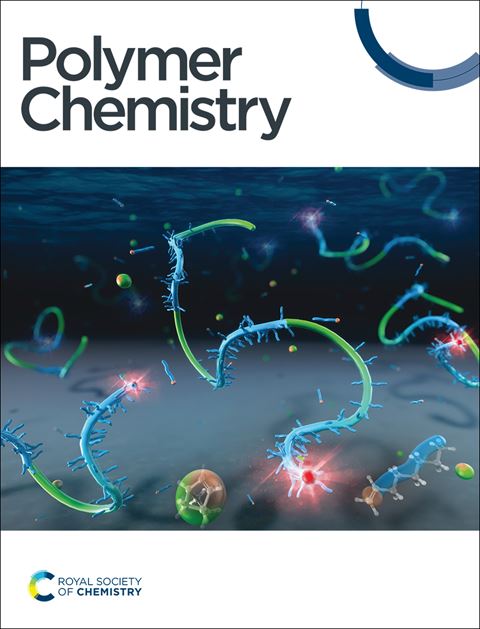Synthesis of periodic polyolefins based on anionic alternating copolymerization†
IF 4.1
2区 化学
Q2 POLYMER SCIENCE
引用次数: 0
Abstract
To avoid sequence bias in the chain growth process of multicomponent periodic polymers, we reported an indirect method for the synthesis of strictly periodic polymers using nonpolar monomers. Using 1,1-diphenylethylene (DPE) as the comonomer, the precise sequence was achieved through living anionic polymerization (LAP) and hydrogenation. Four dienes (isoprene (Ip), 2,3-dimethylbuta-1,3-diene (DMBD), 2,3-diphenylbutadiene-1,3-diene (DPB), and 1-phenyl-1,3-butadiene (1-PB)) and an olefin with cyclic tension 1-cyclobutylvinylbenzene (CBVB) were copolymerized with DPE to prepare the alternating precursors. The periodic sequences of DPE–styrene–propylene (pd-DSP), DPE–propylene–propylene (pd-DPP), DPE–ethylene–styrene (pd-DES), DPE–styrene–styrene (pd-DSS) and DPE–ethylene–styrene–styrene (pd-DESS) were successfully synthesized with hydrogenation of these alternating precursors, and the nonpolar olefin units were successfully introduced into the periodic polymer. The results showed that the modification of the backbone carbon framework structure caused a consistent change in the thermal properties of the polymers. Moreover, the steric hindrance and arrangement density of the side chain substituents could significantly affect the performance of the periodic copolymers. This study provides a feasible method for the synthesis of non-polar periodic copolymers with precise periodic arrangements.

阴离子交替共聚法合成周期聚烯烃
为了避免多组分周期聚合物链生长过程中的序列偏倚,我们报道了一种用非极性单体间接合成严格周期聚合物的方法。以1,1-二苯乙烯(DPE)为共聚单体,通过活阴离子聚合(LAP)和氢化反应获得了精确的序列。四种二烯(异戊二烯(Ip)、2,3-二甲基丁基-1,3-二烯(DMBD)、2,3-二苯基丁二烯-1,3-二烯(DPB)和1-苯基-1,3-丁二烯(1-PB))和一种具有环张力的烯烃-1 -环丁基乙烯苯(CBVB)与DPE共聚制备了交替前驱体。通过这些交替前驱体的加氢反应,成功合成了dpe -苯乙烯-丙烯(pd-DSP)、dpe -丙烯-丙烯(pd-DPP)、dpe -乙烯-苯乙烯(pd-DES)、dpe -苯乙烯-苯乙烯(pd-DSS)和dpe -乙烯-苯乙烯(pd-DESS)的周期序列,并成功地将非极性烯烃单元引入到周期聚合物中。结果表明,主碳骨架结构的改性使聚合物的热性能发生了一致的变化。此外,侧链取代基的位阻和排列密度对周期共聚物的性能有显著影响。本研究为合成具有精确周期排列的非极性周期共聚物提供了一种可行的方法。
本文章由计算机程序翻译,如有差异,请以英文原文为准。
求助全文
约1分钟内获得全文
求助全文
来源期刊

Polymer Chemistry
POLYMER SCIENCE-
CiteScore
8.60
自引率
8.70%
发文量
535
审稿时长
1.7 months
期刊介绍:
Polymer Chemistry welcomes submissions in all areas of polymer science that have a strong focus on macromolecular chemistry. Manuscripts may cover a broad range of fields, yet no direct application focus is required.
 求助内容:
求助内容: 应助结果提醒方式:
应助结果提醒方式:


